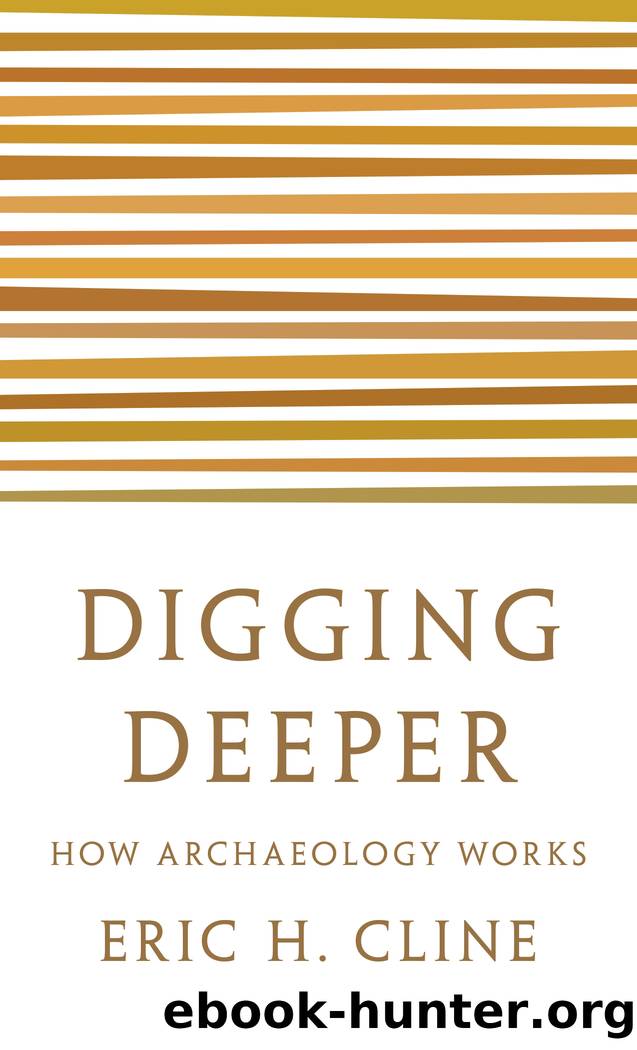Digging Deeper by Eric H. Cline

Author:Eric H. Cline [Cline, Eric H.]
Language: eng
Format: epub
ISBN: 9780691208572
Publisher: PrincetonUP
Published: 2020-08-20T00:00:00+00:00
DIGGING DEEPER 4
HOW DO WE KNOW WHAT THEY ATE, WORE, AND LOOKED LIKE?
In this âDigging Deeperâ chapter, I will briefly try to answer questions like these: âHow do we know what they ate, what they wore, and what they looked like?â as well as âHow do we know what their environment was like?â In other words, how are we able to approach reconstructing what life was like for a person living at a particular time and in a particular place in the ancient world?
* * *
Sometimes itâs veryâor relativelyâeasy to know what people ate in antiquity and even what they looked like while they were alive. For example, because of the conditions in the bog where Lindow Man lay for all those centuries, as described in the previous chapter, his skin and hair are very well preserved, including his beard and mustache. His fingernails are also so well preserved that we can tell they were manicured. Some of his internal organs are also preserved; they contain parts of what was probably his last meal, including a piece of unleavened bread made from wheat and barley, which had been cooked over a fire.1 Similarly, because Tollund Manâs stomach and intestines were preserved, the archaeologists who were called in to examine him were also able to do analyses and to determine that his last meal had been a sort of porridge.2
However, among such accidentally preserved bodies, Ãtzi the Iceman has turned out to be the most important. The scientific discoveries, emerging one after the other, have been published in a series of peer-reviewed and prestigious journals, including Science, the Journal of Archaeological Science, and The Lancet.
Among the discoveries that were made, scientists determined that Ãtzi had brown hair and deep-set brown eyes, a beard, and sunken cheeks. He was probably about five feet, two inches tall and weighed about 110 pounds at the time of his death, which occurred when he was between forty and fifty years old. The strontium isotopes in his tooth enamel, which can be used to determine where people lived during their childhood years, indicate that he probably spent his whole life near where he died, within a sixty-kilometer radius and most likely in a nearby valley in Italy.3
Ãtziâs lungs were blackened, probably from inhaling smoke from campfires, either inside caves or outdoors. He suffered from tooth decay and had been ill several times in the months just before he died. Scientists and archaeologists were able to analyze the contents of his intestines, including pollen, which indicated that he had probably died in late spring or early summer. His last meal included red deer meat, bread made from einkorn, and some plums. In addition, his second-to-last meal included ibex meat, cereals, and various other plants.4
In 2016 scientists who were continuing to study the contents of Ãtziâs stomach also announced that they had mapped the genome of the oldest known pathogen, a bacterium named H. pylori that can cause ulcers. The bacterium may provide a clue to human migration
Download
This site does not store any files on its server. We only index and link to content provided by other sites. Please contact the content providers to delete copyright contents if any and email us, we'll remove relevant links or contents immediately.
| Africa | Americas |
| Arctic & Antarctica | Asia |
| Australia & Oceania | Europe |
| Middle East | Russia |
| United States | World |
| Ancient Civilizations | Military |
| Historical Study & Educational Resources |
The Daily Stoic by Holiday Ryan & Hanselman Stephen(2703)
The Fate of Rome: Climate, Disease, and the End of an Empire (The Princeton History of the Ancient World) by Kyle Harper(2429)
People of the Earth: An Introduction to World Prehistory by Dr. Brian Fagan & Nadia Durrani(2345)
Ancient Worlds by Michael Scott(2098)
Babylon's Ark by Lawrence Anthony(2066)
Foreign Devils on the Silk Road: The Search for the Lost Treasures of Central Asia by Peter Hopkirk(2052)
India's Ancient Past by R.S. Sharma(1982)
MOSES THE EGYPTIAN by Jan Assmann(1968)
The Complete Dead Sea Scrolls in English (7th Edition) (Penguin Classics) by Geza Vermes(1836)
Lost Technologies of Ancient Egypt by Christopher Dunn(1796)
The Daily Stoic by Ryan Holiday & Stephen Hanselman(1764)
The Earth Chronicles Handbook by Zecharia Sitchin(1742)
24 Hours in Ancient Rome by Philip Matyszak(1675)
Alexander the Great by Philip Freeman(1642)
Aztec by Gary Jennings(1539)
The Nine Waves of Creation by Carl Johan Calleman(1518)
Curse Tablets and Binding Spells from the Ancient World by Gager John G.;(1509)
Before Atlantis by Frank Joseph(1481)
Earthmare: The Lost Book of Wars by Cergat(1465)
